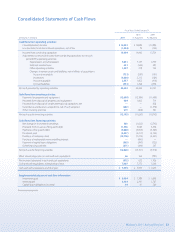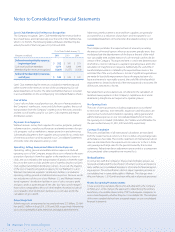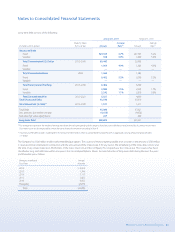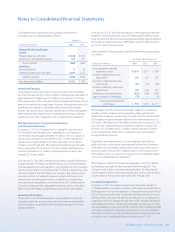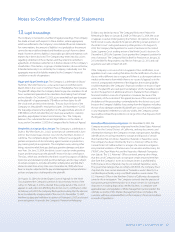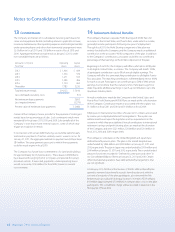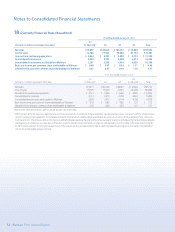Walmart 2011 Annual Report Download - page 45
Download and view the complete annual report
Please find page 45 of the 2011 Walmart annual report below. You can navigate through the pages in the report by either clicking on the pages listed below, or by using the keyword search tool below to find specific information within the annual report.
Walmart 2011 Annual Report 43
9 Derivative Financial Instruments
The Company uses derivative nancial instruments for hedging and
non-trading purposes to manage its exposure to changes in interest and
currency exchange rates, as well as to maintain an appropriate mix of
xed- and oating-rate debt. Use of derivative nancial instruments in
hedging programs subjects the Company to certain risks, such as market
and credit risks. Market risk represents the possibility that the value of the
derivative instrument will change. In a hedging relationship, the change
in the value of the derivative is oset to a great extent by the change in
the value of the underlying hedged item. Credit risk related to derivatives
represents the possibility that the counterparty will not fulll the terms
of the contract. The notional, or contractual amount of the Company’s
derivative nancial instruments is used to measure interest to be paid or
received and does not represent the Company’s exposure due to credit
risk. Credit risk is monitored through established approval procedures,
including setting concentration limits by counterparty, reviewing credit
ratings and requiring collateral (generally cash) from the counterparty
when appropriate.
The Company’s transactions are with counterparties rated “A” or better
by nationally recognized credit rating agencies. In connection with vari-
ous derivative agreements with counterparties, the Company held cash
collateral from these counterparties of $344 million and $323 million at
January 31, 2011 and 2010, respectively. It is the Company’s policy to
record cash collateral exclusive of any derivative asset, and any collateral
holdings are reected in the Company’s accrued liabilities as amounts
due to the counterparties. Furthermore, as part of the master netting
arrangements with these counterparties, the Company is also required
to post collateral if the derivative liability position exceeds $150 million.
The Company has no outstanding collateral postings and in the event of
providing cash collateral, the Company would record the posting as a
receivable exclusive of any derivative liability.
When the Company uses derivative nancial instruments for the purpose
of hedging its exposure to interest and currency exchange rates, the
contract terms of a hedged instrument closely mirror those of the
hedged item, providing a high degree of risk reduction and correlation.
Contracts that are eective at meeting the risk reduction and correlation
criteria are recorded using hedge accounting. If a derivative instrument is
a hedge, depending on the nature of the hedge, changes in the fair value
of the instrument will either be oset against the change in fair value of
the hedged assets, liabilities or rm commitments through earnings or
be recognized in accumulated other comprehensive income (loss) until
the hedged item is recognized in earnings. The ineective portion of an
instrument’s change in fair value will be immediately recognized in earn-
ings during the period. Instruments that do not meet the criteria for
hedge accounting, or contracts for which the Company has not elected
hedge accounting, are valued at fair value with unrealized gains or losses
reported in earnings during the period of change.
Fair Value Instruments
The Company is party to receive xed-rate, pay oating-rate interest rate
swaps to hedge the fair value of xed-rate debt. Under certain swap
agreements, the Company pays oating-rate interest and receives xed-
rate interest payments periodically over the life of the instruments. The
notional amounts are used to measure interest to be paid or received
and do not represent the exposure due to credit loss. The Company’s
interest rate swaps that receive xed-interest rate payments and pay
oating-interest rate payments are designated as fair value hedges. As
the specic terms and notional amounts of the derivative instruments
match those of the instruments being hedged, the derivative instruments
were assumed to be perfectly eective hedges and all changes in fair
value of the hedges were recorded in long-term debt and accumulated
other comprehensive income (loss) on the accompanying Consolidated
Balance Sheets with no net impact on the Consolidated Statements of
Income. These fair value instruments will mature on various dates ranging
from February 2011 to May 2014.
Net Investment Instruments
The Company is party to cross-currency interest rate swaps that hedge
its net investment in the United Kingdom. The agreements are contracts
to exchange xed-rate payments in one currency for xed-rate payments
in another currency. All changes in the fair value of these instruments are
recorded in accumulated other comprehensive income (loss), osetting
the currency translation adjustment that is also recorded in accumulated
other comprehensive income (loss). These instruments will mature on
dates ranging from October 2023 to February 2030.
The Company has approximately £3.0 billion of outstanding debt that is
designated as a hedge of the Company’s net investment in the United
Kingdom as of January 31, 2011 and 2010. The Company also has outstand-
ing, approximately ¥437.0 billion of debt that is designated as a hedge of
the Company’s net investment in Japan at January 31, 2011 and 2010. Any
translation of non-U.S.-denominated debt is recorded in accumulated
other comprehensive income (loss), osetting the currency translation
adjustment that is also recorded in accumulated other comprehensive
income (loss). These instruments will mature on dates ranging from
May 2011 to January 2039.
Cash Flow Instruments
The Company is party to receive oating-rate, pay xed-rate interest rate
swaps to hedge the interest rate risk of certain non-U.S.-denominated
debt. The swaps are designated as cash ow hedges of interest expense
risk. Changes in the non-U.S. benchmark interest rate result in reclassi-
cation of amounts from accumulated other comprehensive income (loss)
to earnings to oset the oating-rate interest expense. These cash ow
instruments will mature on dates ranging from August 2013 to July 2015.
The Company is also party to receive xed-rate, pay xed-rate cross-currency
interest rate swaps to hedge the currency exposure associated with the
forecasted payments of principal and interest of non-U.S.-denominated
debt. The swaps are designated as cash ow hedges of the currency risk
related to payments on the non-U.S.-denominated debt. Changes in
the currency exchange rate result in reclassication of amounts from
accumulated other comprehensive income (loss) to earnings to oset the
remeasurement gain (loss) on the non-U.S.-denominated debt. These
cash ow instruments will mature on dates ranging from September 2029
to March 2034. Any ineectiveness with these instruments has been and
is expected to be immaterial.
Financial Statement Presentation
Hedging instruments with an unrealized gain are recorded on the
Consolidated Balance Sheets as either a current or a non-current asset,
based on maturity date, and those hedging instruments with an unreal-
ized loss are recorded as either a current or a non-current liability, based
on maturity date.
Notes to Consolidated Financial Statements


